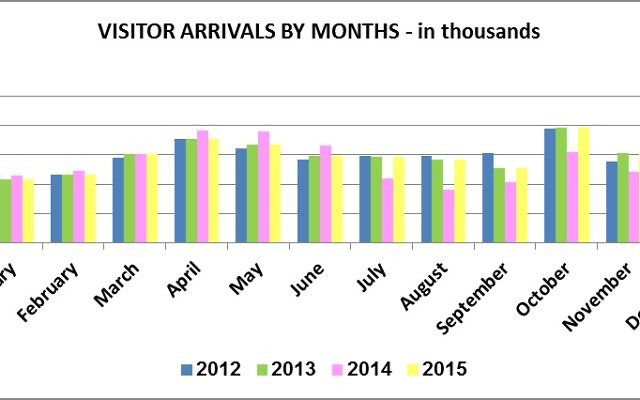Tourism to Israel Drops 3 Percent
Tourism to Israel declined in 2015 for the second consecutive year, with the number of visitors, 3.133 million, down about 3 percent from the total in 2014, the Israeli Tourism Ministry announced Jan. 4.
The numbers in 2014 were depressed by Operation Protective Edge in Gaza during the summer. Compared with the peak tourist year of 2013, the number of visitors in 2015 was down 11.5 percent.
The 2015 totals are preliminary based on estimates for December.
“Looking back at 2015, we see that the entire world is facing a new geopolitical reality. Terrorism has reached places once considered safe tourism destinations. Together we must develop strategies to deal with this new reality, and the main tool is to continue our daily routine, including tourism,” Tourism Ministry Director-General Amir Halevi said in a press release.
He said Israeli tourism showed resilience by dropping only 3 percent in 2015 despite the global turmoil and the rise of individual but deadly terrorist attacks in the last four months of the year.
The 3.13 million visitors include those who make day trips to Israel or stop with cruise ships and thus don’t spend the night. Counting just the tourists who stay overnight, Israel had 2.808 million visitors in 2015, down 4 percent from 2.927 million in 2014 and 5 percent from 2013.
Tourism from the United States, the No. 1 source of visitors to Israel, increased about 2 percent in 2015 from 2014 to a total of 586,000, but decreases of 26 percent from Russia to 392,000 and of 10 percent from the United Kingdom to 184,000 more than offset the American gain.
Based on surveys from the first half of 2015, Christian tourism accounted for 52 percent of Israel’s visitors, while Jewish tourism was responsible for 27 percent. The rest of the visitors represented other religions or claimed no affiliation.
Half of the tourists were first-time visitors.
For the first half of 2015, foreign tourists contributed $9.9 billion to the Israeli economy, the ministry said.
Jerusalem was the most popular city for foreign tourists, 77 percent of whom visited there. Tel Aviv-Jaffa was visited by 69 percent of tourists, followed in popularity by the Dead Sea area (48 percent) and the Galilee, including Tiberias and Sea of Galilee (35 percent).
The Tourism Ministry said tourists overall expressed very good satisfaction with Israel, rating their trips 4.4 out of 5 on average. Archaeological sites, tour guides and organized tours received high ratings (4.5), but visitors were less happy with the value for their money (3.1), access to sites for people with disabilities (3.3), taxis (3.4) and cleanliness of public bathrooms (3.5).

Source: Central Bureau of Statistics, January through November 2015
Israel is taking steps to boost tourism, including trying to make it easier and cheaper to find accommodations by requesting proposals for a chain of budget hotels and enabling a fast-track process for hotel construction. Israel had 369 tourist hotels with a total of 50,243 rooms in the first half of 2015.
“We enter 2016 with an unprecedented budget for overseas marketing and with increased flight capacity, thanks to the open skies policy and Tourism Ministry incentives for Eilat winter flights,” Halevi said. “I invite tourists and pilgrims around the world to include Israel, the land of creation, in their vacation plans for 2016.”






comments